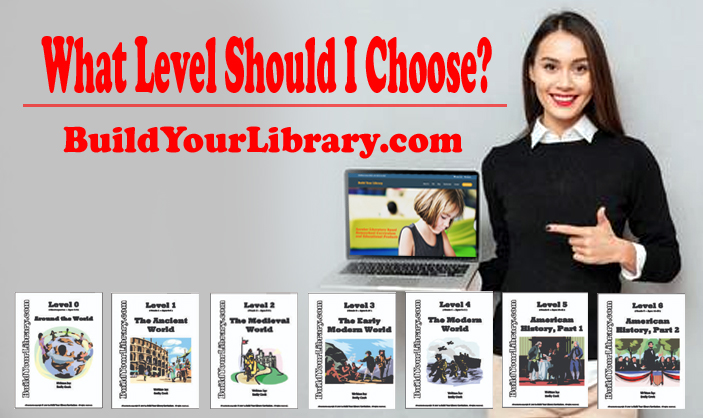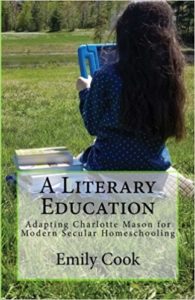What Level Should I Choose?
May 25, 2020
 If you are new to Build Your Library, you might find it overwhelming when deciding where to start. Should you go with your child’s grade level? Or just begin at the beginning so you won’t miss out on any of the fantastic literature selections? If you are homeschooling multiple ages should you combine them in one level or do separate levels with each child? We wrote a brief overview of this in our Levels vs. Grades vs. Ages blog post but will go more in-depth here. The actual answer is not straight-forward, widely depending on your specific situation. Unfortunately this is a case where ifs, ands or buts must be allowed.
If you are new to Build Your Library, you might find it overwhelming when deciding where to start. Should you go with your child’s grade level? Or just begin at the beginning so you won’t miss out on any of the fantastic literature selections? If you are homeschooling multiple ages should you combine them in one level or do separate levels with each child? We wrote a brief overview of this in our Levels vs. Grades vs. Ages blog post but will go more in-depth here. The actual answer is not straight-forward, widely depending on your specific situation. Unfortunately this is a case where ifs, ands or buts must be allowed.
Something I want to get out of the way immediately, is Build Your Library levels do not exactly equate to school grades. Level 1: The Ancient World is not necessarily the same as first grade, but it could be. Most families, without any extenuating circumstances, will probably be fine using Level 0: Around the World for “kindergarten” to be followed in order with Level 1 for grade one, etc.
But, given that, one of the biggest benefits of homeschooling is flexibility. We do not need to be chained to the concept of grade levels. Our levels focus on content subjects, so they can be successfully studied with a range of ages. I list an age range for each level and a good rule of thumb would be to choose on the lower end of the level range suitable for your child’s age. For example, Level 0 is aimed at ages 4 – 6. So if your child just turned 6, Level 0 is a great place to start.
A common issue that I’ve found is if parents start Level 0 too early with a 4-year-old, they may find themselves stuck if that child isn’t quite ready for Level 1 the following year. Level 0 is designed to be a gentle introduction to homeschooling. Often times we suggest the Prehistory Unit Study to help transition between these two levels if that is necessary.
Similarly, there is a leap in maturity between Level 3: Early Modern World and Level 4: The Modern World, mainly due to the difficulty of discussing topics like the World Wars, the Holocaust, and Vietnam. So there may be a benefit to choosing a level that has your child at the higher end of the age-range.
Of course, age isn’t the only thing to consider. Let’s discuss some other factors that you may want to think about when deciding which level to purchase.
Choosing based on the subject matter
Perhaps your eight-year-old is a strong reader and has great reading comprehension. Should you start at Level 1? Or move on to Level 3 because it has independent readers scheduled? The question you should be thinking about is “What subject matter does my child find the most exciting?” If your child is excited about castles, knights, and royalty, then they would get the most out of Level 2: The Medieval World.
I always recommend taking your child’s interests into account. If they are passionate about a topic or asking a lot of questions about a time period, then choose a level based on their interests. I am a big believer in striking while the iron is hot. If they are fascinated with Ancient Egypt, even if they are 8 and going into 3rd grade, Level 1 would be a fantastic choice to start.
Choosing based on where you left off chronologically
If you’ve already been homeschooling for a while and you have just finished studying the middle ages, then Level 3 would be the most logical choice. A chronological study of history makes the most sense to me. It gives your child the ability to see the big picture while learning about history.
But what if you haven’t begun homeschooling yet, or you’ve never studied history? Should you begin at Level 1 so that you can “begin at the beginning?” Yes and no. If your child is younger than 7 or older than 10, Level 1 might not be the best place to begin. Keep in mind that if you continue with Build Your Library through high school, you’ll cover ancients through modern world history two more times, in Level 8 and then again in Levels 10 and 11.
So don’t stress out about needing to start at Level 1 if your child is older. Also remember that Level 5: American History, Part 1, is also the beginning of a history cycle and covers Ancient Indigenous cultures in the Americas through 1850. So if you have a 10 or 11-year-old and you want to start at the beginning of a history cycle, Level 5 is a great place to start!
Choosing based on the required booklist
Is your child a voracious reader? Have they already read most of the books in the level you had planned to begin based on their age? Or maybe you’re worried that your child won’t enjoy the books in a particular level? Either way, looking at the book lists can help you choose where to start.
You’ll want to take into account what books you might already own/have already read, what books you can easily source from your local library, as well as which books you think your child will find the most engaging. I highly recommend, especially if you are homeschooling an older child or teen, to let them look at the book lists with you and choose the level that they find the most interesting. Children learn best when they are engaged with the material, so give them the opportunity to take the lead in choosing what they study.
Choosing a level to study as a family
If you have multiple children who are close in age, I highly recommend combining them into one level. This has so many benefits. One, it’s easier for you to balance one level rather than juggling multiple lesson plans. It also creates a great sibling bond as you are all working together on the same subject. But how to decide where to start? If your children are younger, under age 8, Level 0 or 1 may be a great place to begin.
Try to aim for the middle-ground. Here are two examples:
If your children are 6 and 8, then start with Level 1. The ages listed for Level 1 are 6 – 8. But what if your children are 5 and 7? Should you still begin at Level 1 because your 7-year-old would be ready for that level? Not necessarily. Your 5-year-old is likely not ready for the content of Level 1 and would be better suited in Level 0. By combining them in Level 0, you are ensuring they will both get the most out of Level 1 the following year.
Next, let’s say your children are ages 8, 10, and 12. What level would be the best fit for them? There are many variables here to consider. Is your 12-year-old ready to begin more independent learning? If so, they might be ready to start a level on their own. Perhaps they would enjoy studying Level 7: Exploring Your World. They could tackle the history and science reading on their own and you could just join in for discussion and the read-aloud literature. Then you would just combine your 8 and 10-year-old in one level.
In contrast, if your 12-year-old is not quite ready for that level of responsibility, then I’d recommend combining all three. Level 5 is the beginning of a history cycle, and your 10 and 12-year-olds would get the most out of it. Your 8-year-old is a bit on the younger end of that spectrum, but they could still benefit from tagging along. You could always add in some of the independent readers from the Level 3 curriculum for your 8-year-old, as that level covers roughly the same time period as Level 5.
Will it be too easy if I choose a lower level for an older child?
Not necessarily. History, science, literature, poetry, and art are all content subjects. They aren’t specifically tied to any particular grade level. Your child will still be reading (or learning to read) at grade level, and studying math at grade level. If your 9-year-old is studying Level 1 or Level 2 it doesn’t mean they are doing 1st or 2nd-grade work. You want them to get the most out of the material. That will be more likely to happen when they are mature enough to handle the content.
You also have the unique flexibility to customize the lesson plans to meet your child’s educational capability and expectations. If your child is on the lower end of the range, you can tweak the assignments or projects down to suit their abilities. On the contrary, if your child is at the higher end, or combined with a younger sibling, you can beef up the requirements for that particular child. Assign additional readings, extend the writing assignments or add a research project to delve a bit deeper into the subject matter. All of the lesson plans include optional resources like supplementary book recommendations and documentaries. A simple addition or subtraction may help bridge the gaps.
Deciding which level to begin doesn’t have to be overwhelming. Take these considerations into account, take your child and their interests into account, and remember that there is no right answer. Every child is different and no homeschool curriculum is one size fits all. You know your child best. So go with your gut. You got this!
Full Grade Level Products Available for Purchase at Build Your Library:
Level 0 – Level 1 – Level 2 – Level 3 – Level 4 – Level 5 – Level 6
Level 7 – Level 8 – Level 9 – Level 10 – Level 11 – Level 12
 Emily Cook is the author and creator of the secular homeschool curriculum Build Your Library, a literature-based K-12 program infused with the teachings of Charlotte Mason. She writes full year lesson plans as well as shorter topical unit studies. Emily has been homeschooling her four children in Southern NH for 21 years. She is passionate about reading aloud to children of all ages and loves to share her love of literature with others. She and her family also makes incredibly dorky videos about homeschooling, books and more on Youtube at ARRRGH! Schooling. You can follow her on Facebook, Twitter and Pinterest. You can also check out her author page on Amazon.
Emily Cook is the author and creator of the secular homeschool curriculum Build Your Library, a literature-based K-12 program infused with the teachings of Charlotte Mason. She writes full year lesson plans as well as shorter topical unit studies. Emily has been homeschooling her four children in Southern NH for 21 years. She is passionate about reading aloud to children of all ages and loves to share her love of literature with others. She and her family also makes incredibly dorky videos about homeschooling, books and more on Youtube at ARRRGH! Schooling. You can follow her on Facebook, Twitter and Pinterest. You can also check out her author page on Amazon.
